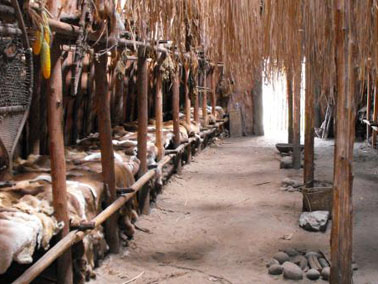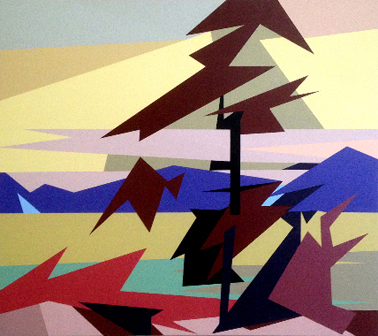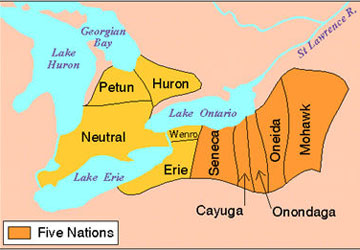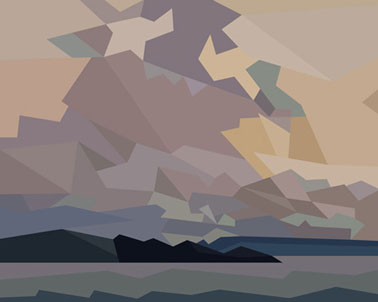Huronia/Wendake Champlain 2015
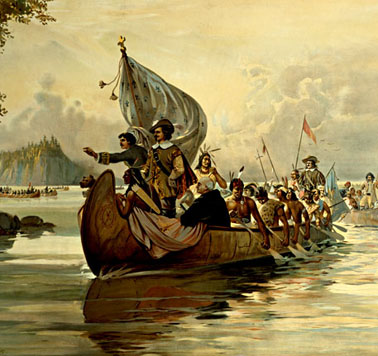
Champlain on Georgian Bay 1615. Painted 1895-1900, John David Kelly, McCord Museum, Montréal M993.154.314.
On August 1, 1615 the French explorer and early Canadian pioneer Samuel de Champlain, travelling in a multiracial party of several large canoes, landed somewhere on the more northerly Georgian Bay shoreline of what is now Simcoe County, due north of the Greater Toronto Area.
This geography was then the heartland of the surprisingly sophisticated agricultural society of what the French called the Huron confederacy, known in its own language as Wendake.
The French encounter with the Huron in the first half of the 17th century marks the dramatic (and even traumatic) opening chapter in the modern “written” history of today’s most populous Canadian province of Ontario.
The 400th anniversary of Champlain’s arrival in old Huronia/Wendake is being celebrated in various parts of Ontario on, before, and after this coming Saturday, August 1, 2015.
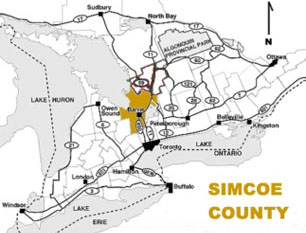 At the peripatetic Linsmore Institute of East York, South Oakville, and East Toronto (and, most recently, the Duke of Gloucester on Yonge Street, south of Bloor), we have been working on a few celebratory notes for the space below, as our contribution to giving the 400th anniversary the attention it deserves.
At the peripatetic Linsmore Institute of East York, South Oakville, and East Toronto (and, most recently, the Duke of Gloucester on Yonge Street, south of Bloor), we have been working on a few celebratory notes for the space below, as our contribution to giving the 400th anniversary the attention it deserves.
It has taken until Canada Day 2015 to pull our contribution here together. But all who have travelled on the same French River that helped take Champlain from present-day Quebec City to Georgian Bay will know the vicissitudes of such adventures. And we are ready now with a few hasty but long-meditated thoughts :
1. General guide
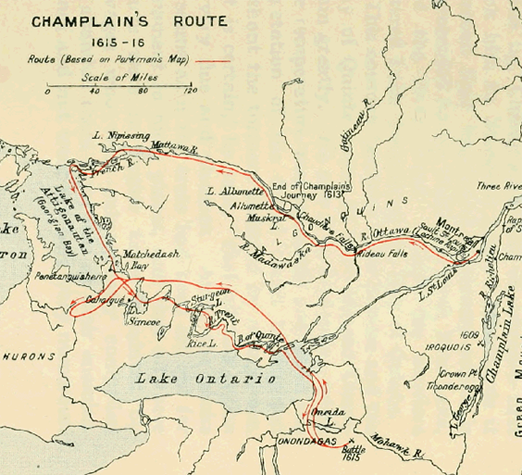
Champlain’s route, based on 19th century historian Francis Parkman’s map. Not every analyst would agree with the exact locations on this particular map. But the August 1 celebration is all about the canoe-party landing somewhere in the quite general vicinity of the dot marked “Penetanguishene.”
For a short guide to some key events in the wider commemoration, see “Ontario Marks 400th Anniversary of Champlain’s Dream All Across The Province This Summer.”
2. Rendez Vous in Penetanguishene
Without neglecting many other intriguing events as noted above and elsewhere, the biggest “Champlain 400” celebration is almost certainly the “Rendez Vous Champlain” extravaganza in the Town of Penetanguishene, on the actual anniversary weekend, Friday 31 July — Sunday 2 August 2015.
CLICK HERE for the detailed schedule, which includes a “Re-enactment of Champlain’s arrival with 20 birch bark canoes and over 150 actors in full-costume” on the morning of Saturday, August 1, 10—11:30 AM.
3. Champlain’s own account
Champlain’s own written account of his introduction to Huronia/Wendake in 1615 is intriguing on several fronts : “After crossing a bay, which forms one of the extremities of the lake, we went some seven leagues until we arrived … at a village called Otoüacha, on the first day of August … The next day …  I went to another village, called Carmaron … where they received us in a very friendly manner, making for us a banquet with their bread, squashes, and fish …”
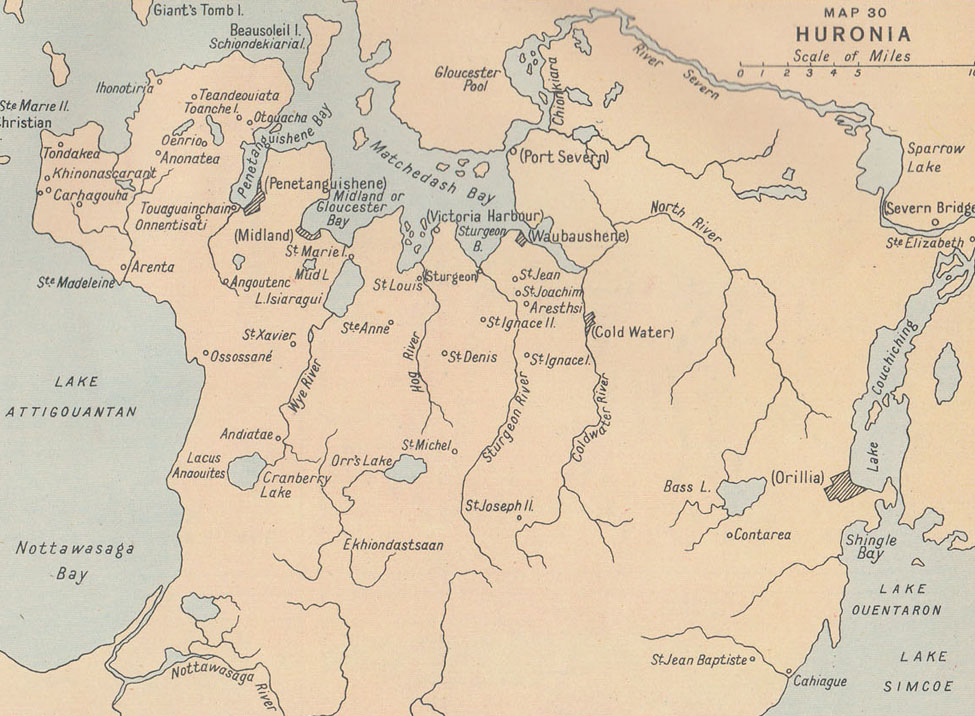
Map of old Huronia./Wendake, with one analysts’s idea of the locations of early 17th century Huron/Wendat villages, and later French missions (and with present-day places in brackets/parentheses).
Champlain goes on : “The chief of this village earnestly begged me to stay, to which I could not consent, but returned to our village, where on the next night but one, as I went out of the cabin to escape the fleas, of which there were large numbers and by which we were tormented, a girl of little modesty came boldly to me and offered to keep me company, for which I thanked her, sending her away with gentle remonstrances … The next day … Â I departed from this village to go to another, called Touaguainchain, and to another, called Tequenonquiaye, in which we were received in a very friendly manner by the inhabitants, who showed us the best cheer they could with their Indian corn served in various styles.”
4. David Hackett Fischer on Champlain’s first impressions
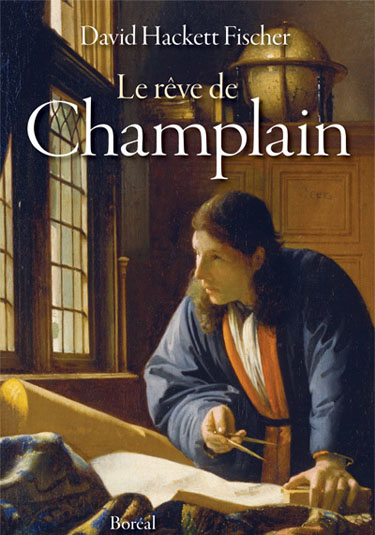 David Hackett Fischer’s Pulitzer Prize winning study of 2008, Champlain’s Dream, has some intriguing things to say about Samuel de Champlain’s first impressions of the Ontario region between what we now call Lake Simcoe and Georgian Bay :
David Hackett Fischer’s Pulitzer Prize winning study of 2008, Champlain’s Dream, has some intriguing things to say about Samuel de Champlain’s first impressions of the Ontario region between what we now call Lake Simcoe and Georgian Bay :
“From Lake Huron Champlain crossed Georgian Bay and entered the country of Huronia. Measured against the vast distances of Canada, it appears very small on a map of this great nation, but Champlain explored it on foot and had a different impression. ‘The whole country which I visited on foot extends for some twenty to thirty leagues,’ he wrote, ‘and is very fine.’”
Champlain reckoned that this country “had an area of about forty by sixty miles, roughly 2,400 square miles.” And it was “well south of the lower St. Lawrence Valley” that would come to host the later Canadian cities of Quebec and Montreal. “Its growing season was long enough to produce abundant crops of corn, and he was impressed by the quality of its soil. ‘This country is very fair and fertile, ‘ he wrote, and he took pleasure in travelling through it.”
Champlain was impressed by the people as well as the geography of Huronia/Wendake in 1615. David Hackett Fischer further explains : “If he was surprised by the extent of Huronia, Champlain was amazed by its population. He described the land as ‘a well-cleared country’ and ‘well peopled with a countless number of souls.’ He tried to count them and came to a rough estimate of thirty thousand inhabitants. He was astonished by the number of towns, and still more by their size and strength. The town of Carhagouha (not the largest) impressed him with its massive triple palisade, thirty-five feet tall, as high as a four-storey building.”
Hackett Fisher goes on : “The Huron villages were surrounded by big cornfields, some larger than a thousand acres.” In the summer of 1615 Champlain “found bumper crops in the fields, much of them nearly ripe in mid-August.”
Moreover : “The production of corn exceeded consumption. Champlain observed that the Huron raised crops for export to other Indian nations. He wrote, ‘They are covered in the pelts of deer and beaver, which they acquired from Algonquins and Nipissing for Indian corn and meal.’ Huronia became the breadbasket of other Indian nations. It also produced an abundance of squashes and sunflowers, plums and small apples, raspberries, strawberries, and nuts.”
5. Ronald Williamson on the current state of the archaeological art
We are fortunate that Ronald F. Williamson, founder of Archaeological Services Inc. in Toronto and a crucial nurturing parent of the archaeological profession in Ontario today, has now completed “The Archaeological History of the Wendat to A.D. 1651: An Overview.”
Our sources say it will appear in the next-to-be-printed issue of Ontario Archaeology.
6. Ontario Archaeological Society symposium “Huronia before and after Champlain”
This will take place in Midland, Ontario, October 16—18, 2015. Â And the event will be jointly hosted by The Eastern States Archeological Federation. It will be held at the Best Western Plus Highland Inn & Conference Centre, 924 King Street, Midland, ON L4R 4L3, Canada.
For further information contact the OAS at 1444 Queen Street East, Suite 102, Toronto, ON M4L 1E1, Phone: +1 (416) 406-5959, Email: info@ontarioarchaeology.org.
Some further references
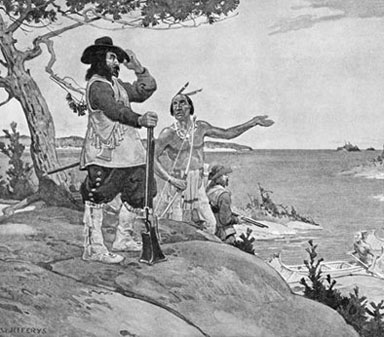
Champlain’s first look at Georgian Bay, C.W. Jefferys, 1925 (Library and Archives Canada/National Archives of Canada fonds/C-000126).
Alan Brunger & Peter Adams, “Trent and Champlain: A bond – Â University has paid tribute to early explorer since its founding days,” Peterborough Examiner.
Bruce Trigger, The Huron : Farmers of the North.
Champlain’s Cross and Celebrations of Champlain’s 400th Anniversary In Canada.
Composer John Beckwith work marks Champlain voyage.
Conrad Heidenreich on Champlain in Huronia.
Creemore event kicks off 400th anniversary of Champlain’s visit to area.
David Montgomery, “The Lost Seven Leagues: Samuel de Champlain’s Landfall in Huronia,” Ontario Archaeology, No. 52, 1991.
Kathryn Labelle, Â Dispersed but Not Destroyed: A History of the Seventeenth-Century Wendat People (2013).
La Clé d’la Baie en Huronie celebrates 400 years of history … since the expedition of Samuel de Champlain.
Tracking Samuel de Champlain’s routes in the Kawarthas … Three men working on a book to commemorate the 400th anniversary of Champlain’s visits to the region.
Travelling with Samuel de Champlain – a map with 12 “points of interest.”
Two exciting events to take place in Lafontaine in 2015 … L’Écho de Champlain en Huronie (April 23—24) … Le Festival du Loup en Nouvelle-France (July 16—19).
Visit and explore Penetanguishene, Ontario, Canada … Tourism, Travel Guide.
Welcome to the Penetanguishene Centennial Museum and Archives.
C.M.W. MARCEL
CANADA DAY, WEDNESDAY, JULY 1, 2015.
